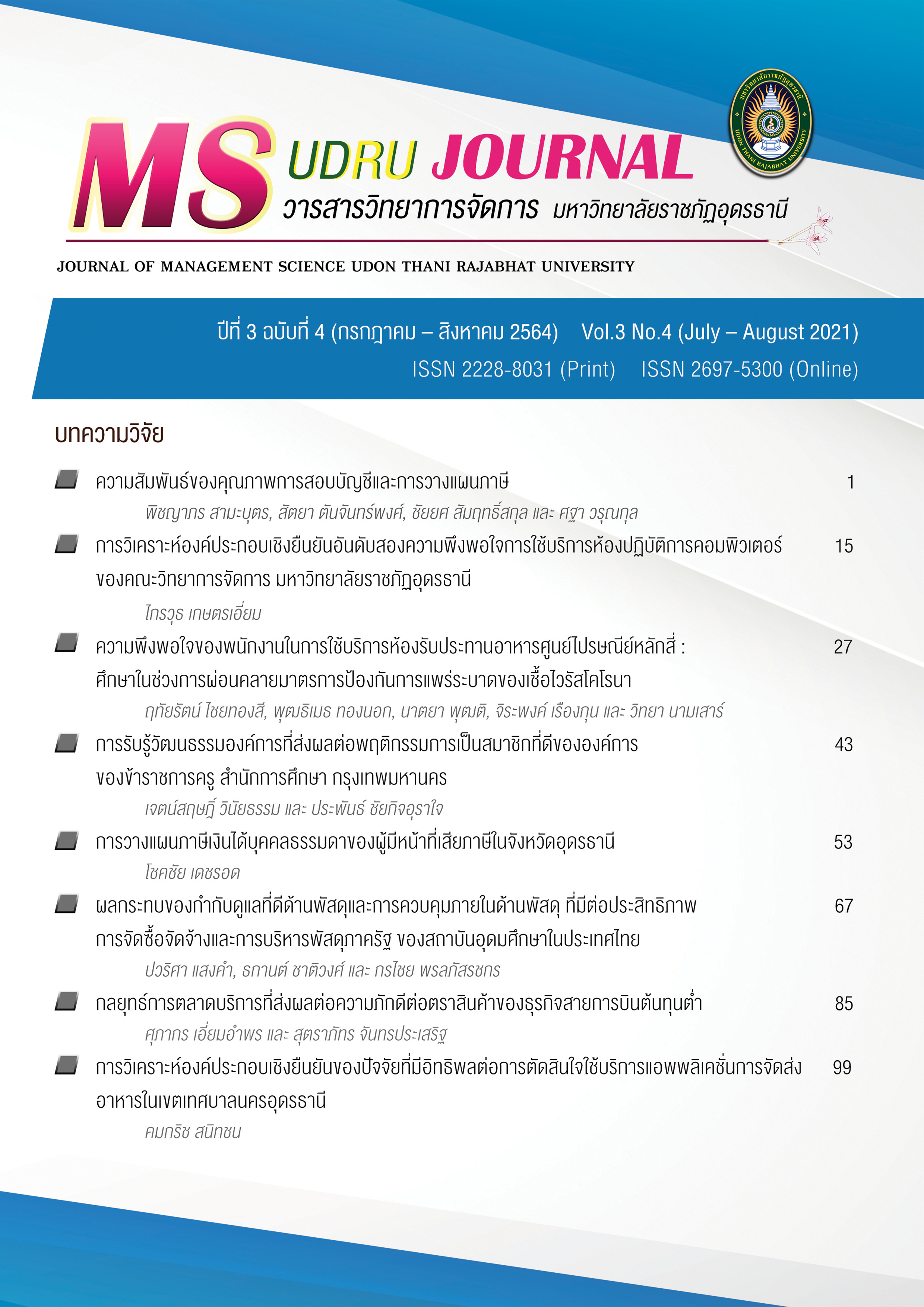CONFIRMATION FACTOR ANALYSIS OF THE FACTORS AFFECTING THE DECISION TO USE FOOD DELIVERY APPLICATIONS IN UDON THANI MANICIPALITY
Main Article Content
Abstract
The purpose of this research was to investigate the goodness of fit between empirical data and the factors affecting the decision to use food delivery applications, using confirmatory factor analysis. The empirical data was obtained from a sample group consisting of 400 respondents, all of whom live in the Udon Thani Municipality. The research instrument used for the data collection was a questionnaire with a five-point rating scale. The data was analyzed using confirmatory factor analysis. The research findings support the Technology Acceptance Model and the integrated marketing communications, which states that the six factors affecting the decision-making process are: Advertising, Public Relations, Sales Promotion, Perceived Usefulness, Perceived Ease of Use and Attitude. The confirmatory factor analysis found the model to be consistent with the empirical data with /df= 1.17, GFI = .96, AGFI = .94, RMSEA = .02 and Standardized RMR = .02. This result can be used by entrepreneurs to determine guidelines and strategies of service for developing food delivery applications system.
Article Details

This work is licensed under a Creative Commons Attribution-NonCommercial-NoDerivatives 4.0 International License.
บทความที่ได้รับการตีพิมพ์เป็นลิขสิทธิ์ของคณะวิทยาการจัดการ มหาวิทยาลัยราชภัฏอุดรธานี
ข้อความที่ปรากฏในบทความแต่ละเรื่องในวารสารวิชาการเล่มนี้ ไม่ใช่ความคิดเห็นและความรับผิดชอบของผู้จัดทำ บรรณาธิการ กองบรรณาธิการ และคณะวิทยาการจัดการ มหาวิทยาลัยราชภัฏอุดรธานี ความรับผิดชอบด้านเนื้อหาและการตรวจร่างบทความแต่ละเรื่องเป็นความคิดเห็นของผู้เขียนบทความแต่ละท่าน
References
กรมการปกครอง. (2561). จำนวนประชากรทั่วราชอาณาจักร ตามหลักฐานทะเบียนราษฎร. กรุงเทพฯ: กระทรวงมหาดไทย.
ชุตินันท์ สงวนประสิทธิ์. (2563). กสิกรไทยชี้โควิด-19 ฉุดรายได้ท่องเที่ยวหด 7.87 แสนล้านบาท คาดวีซ่า STV ช่วยเพิ่มรายได้ 1.5 -2 พันล้านบาท. สืบค้นเมื่อ 22 ตุลาคม 2563, จาก https://thestandard.co/covid-19-tourism-revenue-by-7-87-million-baht/
.
ณัฐศาสตร์ ปัญญานะ และ วัชรพจน์ ทรัพย์สงวนบุญ. (2562). ปัจจัยที่มีผลต่อการตัดสินใจใช้บริการอาหารตามสั่งแบบจัดส่ง. วารสารเศรษฐศาสตร์และบริหารธุรกิจ มหาวิทยาลัยทักษิณ. 11(1), 53-66.
เทศบาลนครอุดรธานี. (2560). การจัดตั้งชุมชนในเขตเทศบาลนครอุดรธานี(เพิ่มเติม). สืบค้นเมื่อ 22 ตุลาคม 2563, จาก http://udoncity.go.th/public4/sites/default/files/news/การจัดตั้งชุมชนในเขตเทศบาลนครอุดรธานี.pdf
ยุพเรศ พิริยพลพงศ์. (2558). ปัจจัยและพฤติกรรมที่มีผลต่อการตัดสินใจใช้โมบายแอพพลิเคชั่นซื้อสินค้าผ่านทางสมาร์ทโฟนและแท็บเล็ตของผู้บริโภค ในเขตกรุงเทพมหานคร. ใน การประชุมวิชาการระดับชาติ ประจำปี 2558 สถาบันบัณฑิตพัฒนบริหารศาสตร์. หน้า 301-317.กรุงเทพฯ: สถาบันบัณฑิตพัฒนบริหารศาสตร์.
ศูนย์วิจัยกสิกรไทย. (2563). หลังโควิด-19 ธุรกิจ Food delivery ขยายตัวบนการแข่งขันที่ยิ่งรุนแรง..ผู้ให้บริการแพลตฟอร์มรุกไปสู่ Super Application. สืบค้นเมื่อ 22 ตุลาคม 2563, จาก medias.thansettakij.com/pdf/2020/1596647026.pdf.
ศูนย์วิจัยกสิกรไทย. (2563). หลังโควิด19 แพลตฟอร์ม On-demand สร้างโอกาสทางธุรกิจเหมาะกับเงื่อนไขความต้องการที่ต่างกัน. สืบค้นเมื่อ 22 ตุลาคม 2563, จาก https://kasikornresearch.com/th/analysis/k-social-media/Pages/On-Demand-FB0705.aspx.
สำนักงานสถิติแห่งชาติ. (2562). รายงานสถิติจำนวนประชากรและบ้านประจำปี พ.ศ. 2562. สืบค้นเมื่อ 22 ตุลาคม 2563, จาก http://stat.bora.dopa.go.th/stat/statnew/statTDD/views/showDistrictData.php?rcode=41&statType=1&year=62.
สุวิมล ติรกานันท์. (2555). การวิเคราะห์ตัวแปรพหุในงานวิจัยทางสังคมศาสตร์. พิมพ์ครั้งที่ 2. กรุงเทพฯ: จุฬาลงกรณมหาวิทยาลัย.
Belanche, D., Flavian, M. & Rueda, A.P. (2020). Mobile Apps Use and WOM in the Food Delivery Sector: The Role of Planned Behavior, Perceived Security and Customer Lifestyle Compatibility. Sustainability 2020, 12(4275), 1-21.
Chai, L.T. & Chiang Yat, D.N., (2019). Online Food Delivery Services: Making Food Delivery the New Normal. Journal of Marketing Advances and Practices, 1(1), 64-79.
Cho, M., Bonn, M.A. & Li, J. (2019). Differences in Perceptions about Food Delivery Apps Between Single-person and Multi-person Households. International Journal of Hospitality Management, 77, 108-116.
Donthu, N. & Gustafsson, A. (2020). Effect of COVID-19 on Business and Research. Journal of Business Research, 117, 284-289.
Fill, C. (2013). Marketing Communications: Brands, Experiences and Participation. 4th edition. Harlow, England: Pearson Education.
Haider, T. (2018). A Study on the Influences of Advertisement on Consumer Buying Behavior. Business Studies Journal. 9(1), 1-13.
Hair, J, F., Black, W.C., Babin, B. J. & Anderson, R, E, (2010). Multivariate Data Analysis. Prentice Hall: Upper saddle River, NJ.
Kotler, F. & Keller K.L. (2016). Marketing Management. Global edition. Harlow, England: Pearson Education.
Li, C., Mirosa, M. & Bremer, P. (2020). Review of Online Food Delivery Platforms and their Impact on Sustainability. Sustainability 2020, 12(5528), 1-17.
Nunnally, J. C. (1978). Psychometric Theory. New York: McGraw Hill.
Panse, C., Rastogi, S., Sharma, A., & Dorji, N. (2019). Understanding Consumer Behaviour towards Utilization of Online Food Delivery Platforms. Journal of Theoretical and Applied Information Technology. 97(16), 4353-4365.
Piriyakul, M., (2010). Partial least square path modeling. Proceedings of the Applied Statistics Symposium, June 20-23, 2010, USA.
Rovinelli, R.J.& Hambleton, R. K. (1977). On the Use of Content Specialists in the Assessment of Criterion referenced Test Item Validity. Dutch Journal of Education Research, 2, 49-60.
Salunkhe, S., Udgir, S. & Pdtkar, S. (2018). Technology Acceptance Model in Context with Online Food Ordering and Delivery Services: An Extended Conceptual Framework. Journal of Management, 5(5), 73-79.

